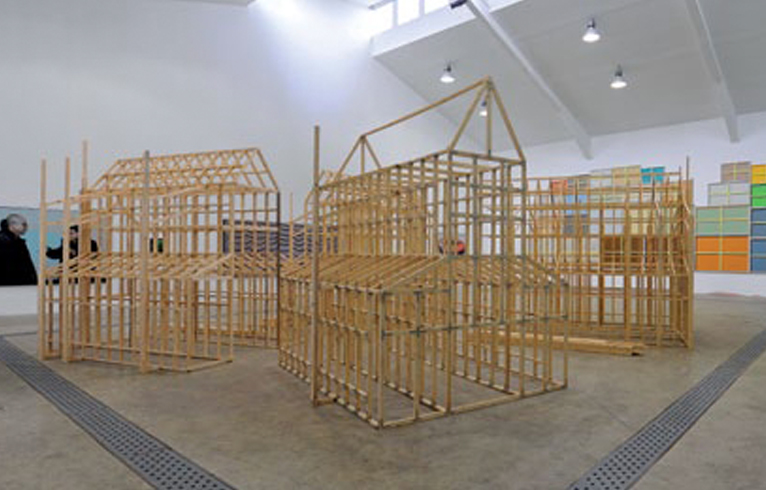SURPLUS GOODLOOKINGNESS
| December 13, 2011 | Post In LEAP 11

To get an idea of what this exhibition is like, it is perhaps best to start with a description of Liang Shuo’s Fortified Colors (2011), an installation of multicolored affordable household items stuffed behind three pieces of glass to form an extremely soft and colorful screen. However, behind is an entirely different scene: chaotic furniture legs, vulgar disarray, and a seemingly fragile wooden structure supporting the three glass walls. The work presents an obvious visual and conceptual contrast. In order to expose the discrepancy between the visual and its underlying mechanism, this useless structure has been exaggerated and made ugly.
Ugliness lies behind the “good-looking,” and this ugliness is long-winded, cumbersome and ridiculous. This is the premise of the exhibition. In his brief introduction, curator Bao Dong summarizes his intent in two points: “The works in today’s exhibition are regarded as residue extruded from the artistic and aesthetic system,” and “to rethink the visual-centrism of the exhibition and resist the ‘landscaping’ of works.” Rampant visual-centrism— the “retinal art” that Duchamp famously reacted against— is the vulgar spawn of visual arts institutions; it leads to a “superficialization” of art. But as a response, this visual-centrism has at least one twin, and that is “conceptualization,” and this conceptualization’s dependence on the text complicates the internal structure of art. Bao Dong’s critique of visual-centrism suffers from this, using the spear of conceptualism to attack the shield of visual-centrism. We see that the works in this exhibition, apart from those of Zhang Hui and He Chi and paintings such as Xu Tan’s Keywords, are all highly conceptual installations, videos, and so on. Bao Dong’s preface claims that it is worth re-looking at “art’s internal structure.” He is absolutely right. Take, for example, Li Qing’s series of works about “games”: given the absence of supporting text, it must be viewed three to five times in order to begin to make sense of it.
When artworks are inserted into this conceptualized structure, the result is predictable: thoughtful artists, no doubt, would make the exhibition interesting, resistant to easy interpretation, but this would inevitably render the exhibited work prone to ambiguity. Euphemistically expressing the artist’s values, Shi Qing’s Whatever art is demanded, will be produced (2011) cites utopian socialist theorist Ruskin’s quote on Gothic architecture and the social relations of production. Ambiguity arises in the four wooden imitation Gothic buildings built by the artist and his workers. We tend to focus on this production model, of artists hiring workers to jointly create works, only to ignore two subtle underlying motifs. One, Gothic architecture was stone-based, but the artists choose to use wood for reconstruction. And two, with detailed observation, we find that the object itself is not structurally stable, but rather, it relies on the shoddy use of nails to hammer strips of wood together. This indicates that the work does not generate so-called structure, but is merely a parody of Gothic appearances. If visual-centrism manifests itself more as virtuous and “goodlooking,” then will an ugly exterior become a form of visual-centrism? Or, has the artist simply cut corners? This does not accord with the artist’s usual proclivity for concealing complexity within simple semblance.
Under the assumed premise that “the curator has carefully considered this exhibition and its every detail,” this exhibition stands the test of careful observation. For example, as raised in the forward, the exhibition “tries to be a critique.” The reality is, due to various constraints, such as exhibition space, the relationship between the curator and artist, and so on, this critique remains only an attempt, a possibility. Its effectiveness is not inevitable. Likewise— as the curator stated— should the focus of attention change, it would be worth our time to revisit the exhibition. Indeed, the trap has been set, we have now been drawn into it, it is unlikely we shall escape. Po Hung (Translated by Jason Fitts)

